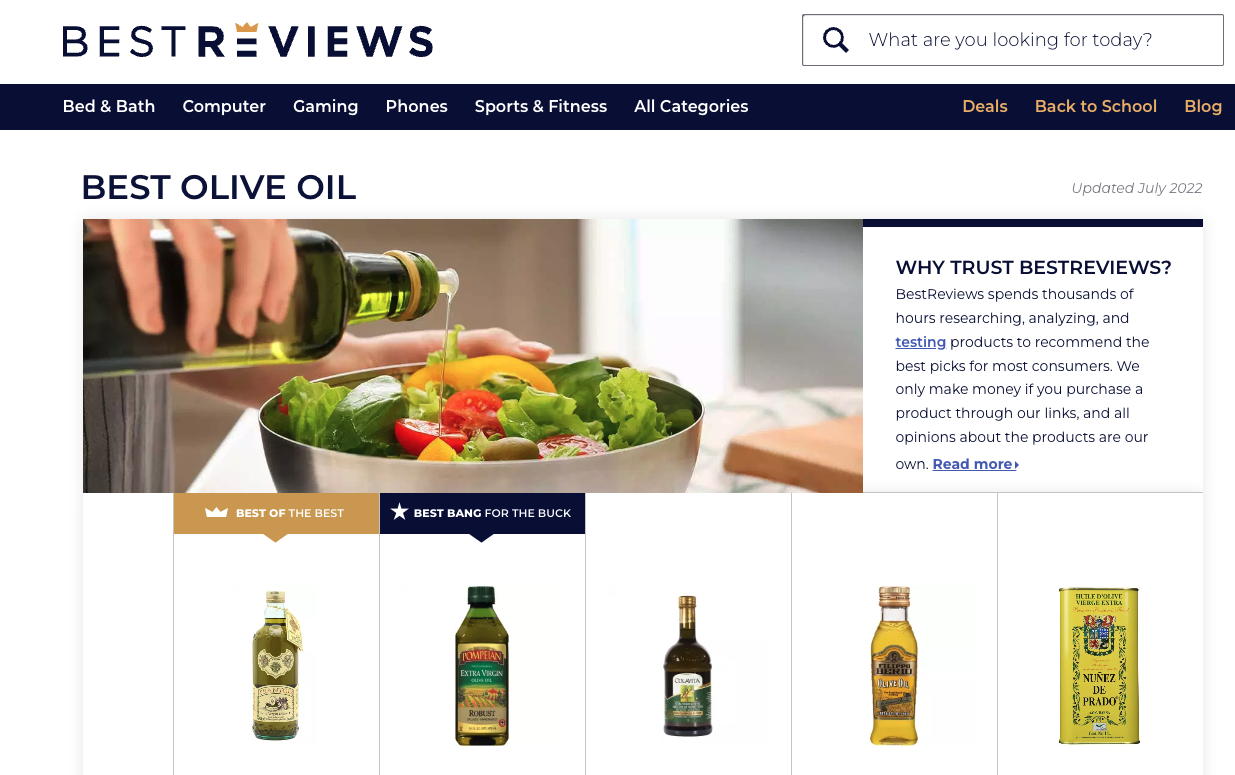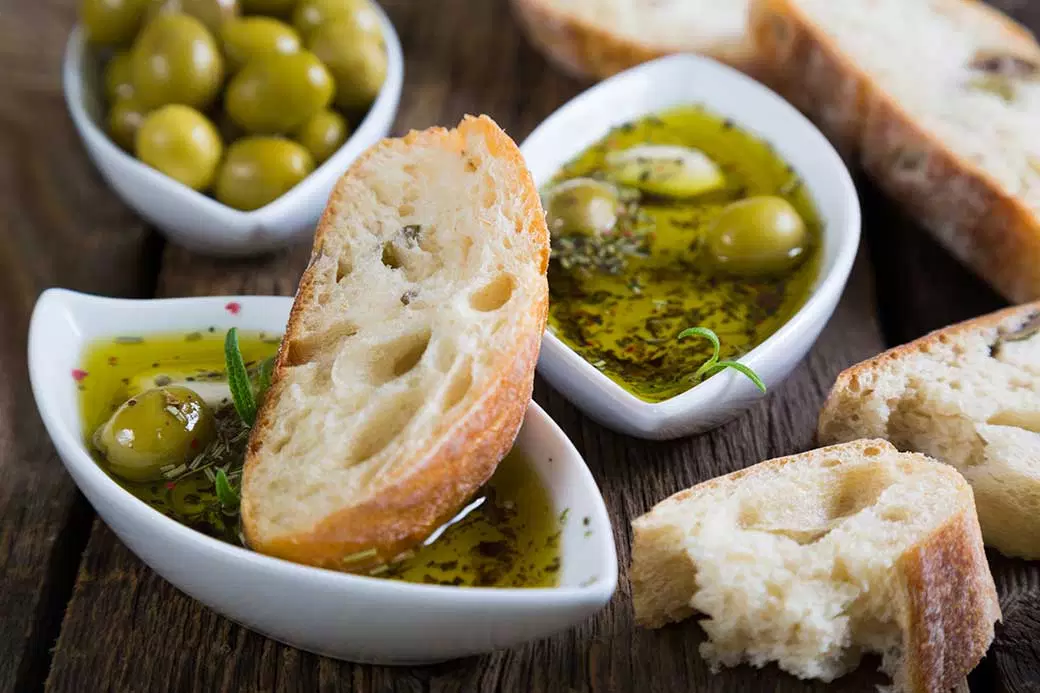
Best Olive Oil
When buying olive oil, preference plays a big part in selection, but a quick scan of a bottle’s label can tell you a lot about the quality and provenance of the product. As with buying wine, a bit of know-how helps immensely when it’s time to pick out a new bottle of this popular cooking oil. Whether you prefer to use it to drizzle onto foods like hummus, mix it into salad dressings, or sautée veggies with it, there’s an olive oil option out there to suit your needs.
Olive oil is a delicious, healthful oil that’s easy to track down in the supermarket. Every grocery store has a variety of olive oils on offer. The trouble is that not all bottles are created equal. A handful of buzzwords and descriptors are used on labeling to entice shoppers, but often, these fancy-sounding phrases are unregulated and have no bearing on the oil’s flavor and quality.
So, how does one go about selecting an olive oil with a robust flavor profile? Discover an array of olive oil-related tips to help you shop for this popular culinary staple.

Olive oil is not a neutral-tasting oil. Buy high-quality extra-virgin olive oil and enjoy its strong flavor in a variety of dishes. Dip bread in a mixture of olive oil and vinegar. Sauté onions in olive oil for an Italian ribollita soup. Choose another oil, such as grape seed, when you do not wish to impart flavor to your dish.
Health benefits of olive oil
Fat has gone in and out of fashion as an ingredient and is now back in vogue thanks to research that proves its value as a health food. The Mediterranean diet, long regarded as one of the healthiest diets on the planet, relies heavily on this type of fat. The healthiest olive oil form is extra-virgin. Because light or pure olive oils are so heavily processed, many of the healthful components are removed during the extraction process. Certain brands even dilute their olive oils with other neutral-tasting oils.
Extra-virgin olive oil is high in vitamin E and K. It also contains plenty of antioxidants, which are thought to have anti-inflammatory properties. There’s also evidence that consuming extra-virgin olive oil protects against high cholesterol, high blood pressure, heart attack, and stroke.
FEATURES
Unfiltered vs. filtered
You’ll notice tiny specks inside a bottle of unfiltered olive oil. The oil still contains bits of olive flesh and has a shorter shelf life than filtered olive oil.
Packaging
Choose olive oils packaged in dark glass bottles or metal cans. Exposure to light may cause premature spoilage. Check the container for the harvest date and don’t buy olive oil that’s set to expire sooner than a year after purchase.
Dispenser
Dispenser types vary from screw-on lids to gentle-pour tops. A bottle with a fancier lid that helps to slow the flow rate of the oil may come with a premium price tag. But if you know how to slow the flow of oil with your index finger or thumb, you can often save yourself some money. You can also buy a dedicated olive oil dispenser to be guaranteed uniform flow no matter which brand you choose.
Flavoring
Sets of infused olive oils make an excellent gift and are great for using as a garnish or in salad dressings. Popular flavors include lemon, chile, and various herbs.
OLIVE OIL PRICES
The higher the quality, the pricier the bottle of olive oil. Artisanal oils also fetch a higher price.
In the $10 to $15 range, you’ll find pure and virgin olive oils in 1 liter quantities or less. Olive oils in this price range don’t typically have origin information included on the label.
Expect to pay $15 to $25 or more for a premium, high-quality bottle of extra virgin olive oil from a reputable or artisanal producer.
You’ll likely pay more than $25 for a bottle that’s larger than 500mL.

TIPS
- Buy a small bottle of the highest-quality olive oil you can afford and save it for garnishing and dressing dishes.
- If your budget is limited, but you want to cook with olive oil, opt for lower-priced bottles of virgin oil.
- Use richly flavored olive oil to make sauces and dips.
- Infuse olive oil on your own at home using garden-grown herbs such as rosemary or thyme. Herb-infused olive oil tastes delicious and makes an excellent bread dip when mixed with high-quality balsamic vinegar.
- Don’t use olive oil for frying foods. The smoke point is too low for extremely high-heat cooking.
- High-quality and artisanal olive oils make an excellent gift.

FAQ
Q. Does the color of olive oil mean anything? What about the term cold-pressed? Does it denote quality?
A. No. The color of olive oil has nothing to do with flavor or quality. Olive oil color varies according to the type of olive used and its ripeness at the time of extraction. A bottle labeled cold-pressed or first cold-pressed points to the method used to extract extra-virgin oil. According to standards set out by the International Olive Council, all certified extra-virgin olive oils are required to be first cold-pressed, so a label with this information isn’t particularly meaningful.
Q. What’s the best way to store olive oil?
A. Store bottles of olive oil in a cool, dark place, like your kitchen cupboard. Don’t leave the contents of olive oil containers or bottles exposed to air. Don’t store olive oil in the refrigerator — doing so may alter the flavor.
Q. How can I tell if olive oil has gone rancid?
A. Rancid olive oil has a distinctly sour or stale-nutty scent. High-quality extra-virgin olive oil will spoil faster than other types of olive oil. The presence of sediment doesn’t mean your olive oil has spoiled, however. It’s likely just unfiltered.
Q. Is it true that cooking with olive oil at high temperatures is unhealthy because it releases toxins?
A. Although there’s a fair bit of controversy surrounding the topic of high-heat cooking with olive oil, it’s all just a bunch of smoke. Research shows that cooking at high heats with this oil is safe and doesn’t create any adverse health risks.







